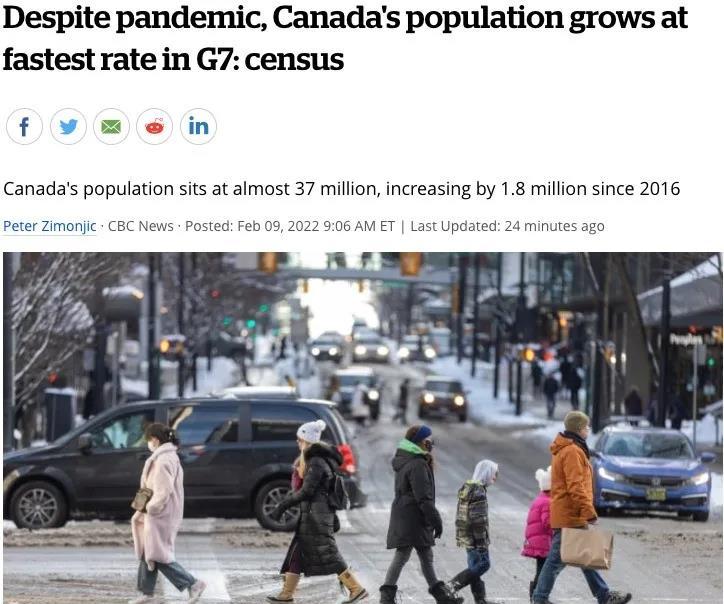
Statistics Canada today released the results of the 2021 Census, with a total population of 36,991,981 in May 2021, an increase of 1.8 million from 2016, thanks in large part to new immigrants. Add in more than 200,000 new immigrants in the second half of 2021, and Canada's current population has exceeded 37 million.
According to newly released 2021 Census data, Canada remains the fastest-growing country in the G7 despite the pandemic.
Total population of Canada: 37 million
According to newly released census data, the total population of Canada in June 2011 was 36,991,981, an increase of about 1.8 million people living in Canada compared to five years ago, an increase of 5.2% in five years.
Despite the pandemic, Canada's population grew almost twice as fast as in other G7 countries from 2016 to 2021.
This is largely due to the growth of the immigrant population, rather than the local birth rate.
Canadian immigration is the driver of Canada's population growth from 2016 to 2021, despite border restrictions due to the spread of COVID-19.
Ontario 14 million
Canada's fastest-growing region is the Maritime Provinces region, which has outpaced prairie provinces for the first time since the 1940s, much of that growth is attributed to immigration from abroad and inter-provincial migration within Canadians.
Ontario has 14,223,942 people, an increase of about 800,000 people in the past five years, an increase of 5.8%.
Canada's second-largest province is Quebec, with a population of 8.5 million 1,833 people, an increase of 4.3%.
Of the 10 provinces, the one with the fastest growth rate was Prince Edward Island, with a growth rate of 8%. Newfoundland and Labrador, also Atlantic provinces, were the only provinces with declining populations, down 1.8 percent over the past five years.
Greater Toronto: 6.2 million
Of Canada's 38 million people, nearly 72 percent of that, about 27.3 million Canadians live in 41 metropolitan urban centres, including 6.2 million in the Greater Toronto Area.
The 416 district of the City of Toronto has a population of 2,794,356, an increase of 60,000 in the past five years, an increase of 2.3%
There are 338,503 people in markham, which is inhabited by Chinese in the north, and the number of people has increased by less than 10,000 in the past five years, an increase of 2.9%, far below the average.
Richmond Hill 200,000 people, 3.6% increase in population
Metro Vancouver: 2.6 million
Metro Vancouver had 2.64 million people, up 7.3 per cent, well above the national average
Greater Montreal: 4.3 million
Greater Calgary: 1.48 million
It can be seen that the population of the four major cities of Dawen, Dawen, Dameng and Daka has a population of about 15 million, accounting for about 40% of the total population of Canada.
2022 Hot Work Visa Project Recommendation
New Zealand Home Work Visa Program
New Zealand three-year work permit, no language score, $27 per hour, spouse and children can enter public schools for free.
Recommended for popular immigration projects in 2022
A manual signature, the family moved to Canada. Children receive Free Western education, and the tuition fees of famous universities are also charged by local students, the same as international students, but the cost is much lower than that of international students, the choice of majors is wide, and employment is also greater than that of international students. It is also relatively simple to enroll in 211,985 domestic schools as international students. This is a good way for ordinary working-class or even middle-class people to change their fate.
Immigration, in order to pursue a predictable and happy life
Immigrants for children to be able to receive a better education
Immigration is not a sublime foreign, but a consideration of one's own synthesis.
It is to neutralize the environment, medical care, education, food safety, etc. at home and abroad, and choose a good environment for future generations.